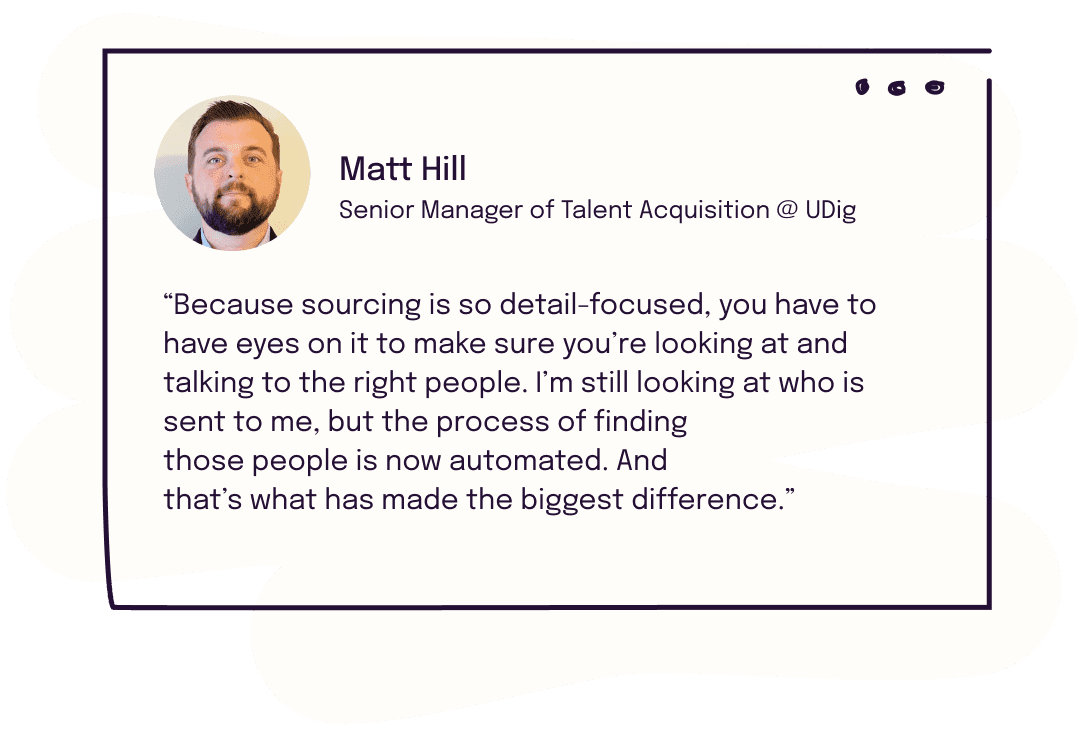Customer stories
How UDig saved 8-10 hours a week with automated sourcing
How UDig saved 8-10 hours a week with automated sourcing
UDig moved away from monotonous, manual sourcing to free up time. In the process, they discovered they could automate top-of-funnel processes and save 8-10 hours a week, while still building high-quality pipeline.

About
UDig is a technology consulting firm focused on enabling your business with custom software, data and intelligent automation solutions.
101-250
Richmond, VA
Business Services
TL;DR: UDig moved away from monotonous, manual sourcing to free up time. In the process, they automated top-of-funnel processes and saved 8-10 hours a week, while still building high-quality pipelines.
Introduction
The challenge
The solution
The result
Introduction
Sourcing smarter to meet aggressive goals
UDig, a technology consulting company, had aggressive hiring goals for 2022. Matt Hill, Senior Manager of Talent Acquisition at UDig, recognized that they’d need to offset their sourcing efforts for the company’s two-person recruiting team to meet those goals.
The challenge
Monotonous, manual sourcing wasn’t delivering
At the time, he and his colleague relied primarily on LinkedIn Recruiter to build their candidate pipelines. On light interview days, he’d spend two to three hours sourcing talent on LinkedIn. He risked falling behind on the sourcing side on heavy interview or meeting days.

He realized that after a while, scouring over the same search results and the same candidates wasn’t the best use of his time. The monotony of manual sourcing, especially for highly specialized tech roles, eventually became less productive and more draining.
“It can get really repetitive on LinkedIn Recruiter. Even if you switch up searches, you’re looking at the same interface,” says Matt. “I thought we may be missing people we want to talk to because our eyes start glazing over.”
He was curious about creative sourcing solutions that would minimize the amount of manual searching he’d have to do and scheduled a demo with Fetcher.
The solution
The power and personalization of automation
The UDig team first partnered with Fetcher in March of 2022. They started utilizing Fetcher to build their tech talent pipelines and getting batches of sourced candidates sent to their inboxes twice a week.

Matt now shares the initial batch of candidates with the hiring manager to ensure his search parameters align with their needs.
From there, he integrated Fetcher into Slack to receive and provide feedback on Fetcher-sourced candidates even faster.
Once he finds a candidate to connect with, he adds them to an email sequence with one click in Fetcher. On top of the time saved by automating follow-ups, he’s also seen higher response rates by emailing through Fetcher versus InMail.
The result
Maximizing candidate outreach and recruiting efficiency
With Fetcher, UDig has a 38% interested rate from candidates and made three successful tech hires last year. With automated sourcing, Matt and his team can have interview-heavy days without worrying they’ll fall behind in finding new prospects. It also gives UDig’s recruiters more bandwidth to improve their processes outside of sourcing.
“I really use Fetcher as my main sourcing tool because I want it all to come to me,” Matt adds. “I can focus on other projects that can add value at UDig elsewhere, like interviewing or interview scorecards. I can focus on those things because I know sourcing is still going on in the background.”
Moving forward with Fetcher
When renewal came around in early 2023, Matt had to decide between keeping his LinkedIn Recruiter seat or Fetcher. Fetcher had already shown its value by saving Matt time while still delivering interested, quality candidates, so he discontinued his LinkedIn Recruiter license and leaned into Fetcher.

With Fetcher’s Chrome Extension, Matt can still add candidates he finds on LinkedIn to his pipeline in Fetcher. This year, he plans to implement more nurture campaigns and reconnect with UDig’s talent pool through Fetcher’s Directory features.
“I didn’t think it was possible to automate this part of recruiting,” adds Matt.
38%
average
interested rate
8-10
hours
saved per week

